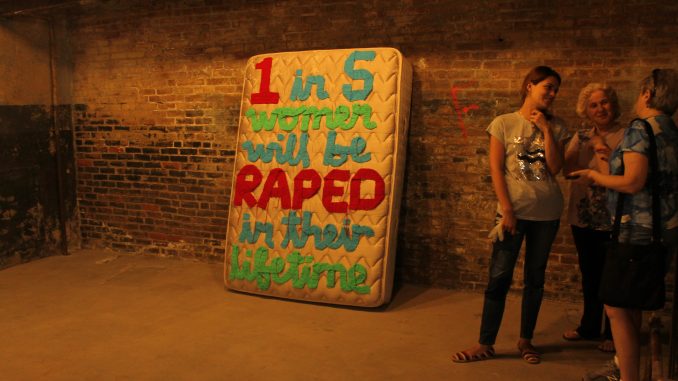
Last week, Hillary Clinton made history at the Democratic National Convention, becoming the first woman to lead a major political party in a presidential election.
Meanwhile, Philadelphia artist Russell Craig was busy breaking a glass ceiling of his own. He stood tirelessly in front of his larger-than-life self-portrait at the Truth to Power exhibit on 9th and Spring Garden streets.
The pop-up exhibit, an initiative led by nonpartisan organization Rock the Vote, delved into topics ranging from immigration reform to police brutality. Awestruck audience members observed dozens of pieces, while speaker panels discussed sociopolitical issues like environmental racism and mass incarceration. From July 25 to 27, the 990 Spring Garden art space was filled with the work of more than 100 artists; Craig was one of them.
“I tried my best. I pushed myself to be great,” Craig said.
A closer look at Craig’s canvas of choice一an orderly patchwork of prison indictment and release papers一acknowledged a turbulent past.
Prison was the turning point in Craig’s life. Once convicted of drug charges, he sharpened his reading and writing skills, received his GED and turned to art.
“A guy can come from that dark background, you know, of failure, or of being a criminal or whatever, and change it around,” Craig said.
The portrait brims with symbolism. Craig rendered his face with a translucent layer of pastel to allow the words of his prison papers to shine through. The canvas, broken into four sections, points at the center of Craig’s face like a crosshairs.
“This is behind me. But the stigma and reality is that it’s not behind me,” Craig said. “I’m a felon; I’ll always be looked at as a criminal from some people.”
As the exhibit progressed, Craig received praise from admiring audience members like musician Will.I.Am, actress Rosario Dawson and Sen. Cory Booker.
Many participating artists were Philadelphia-based一 like yarn-bombing Temple alumna Ishknits一while others came from far and wide to contribute to the cluster of creation.
“I’m like a local artist, not known, and these are famous artists,” Craig said.
The platter of poignant pieces created a head-swiveling effect.
Michael Murphy’s “Identity Crisis”, an assemblage of suspended guns, formed both the shape of a massive pistol and the outline of the United States from different points of view. Brooks Bell, the artist responsible for painting a Bernie Sanders mural on 4th and Bainbridge streets last December, contributed a neon sign, bluntly entitled, “Corporate Media Still Sucks.”

Artist Drew Leshko said the exhibit had one overarching theme: awareness.
“Art has always been important with all political movements. And I don’t think that’s any different here,” Leshko said.
Leshko’s piece, a miniature, three-dimensional model of a school bus in disrepair, represented a real-life, broken down vehicle he had noticed. Known for his intricate models of buildings undergoing gentrification, Leshko has used his surrounding environment一the transitioning neighborhood of Fishtown一to question consumer culture and wastefulness.
“It’s such a straightforward metaphor maybe it’s not even one: the broken down schoolbus, the broken down school system in Philadelphia,” Leshko said of his piece.
Michael D’Antuono, who contributed three richly colored paintings, said the exhibit highlighted social injustice一a necessary topic to discuss during the DNC.
“How do you fix something if you don’t admit there’s a problem?” D’Antuono said.
D’Antuono encountered artistic criticism in 2009, when he painted President Obama wearing a crown of thorns. The Christ-like depiction became so controversial that it was not displayed for three years. Still, D’Antuono continued to created politically charged art.
“From there I took off, and said that this is what I’m dedicating the rest of my life to,” D’Antuono said. “I’m gonna paint, I’m gonna paint about issues, and they don’t like it? Don’t look at it.”
In Truth to Power, D’Antuono’s “The Talk” showcased an intimate scene in which two black parents spoke to their son. In the background of the painting, a television screen announced the acquittal of a policeman who’d shot an unarmed black man.
“Imagine having to have that conversation with your child,’ D’Antuono said. “So many parents have told me, ‘yes, we’ve had to have the talk.’”
The artwork, paired with the political climate of the DNC, facilitated powerful discussion.
“This right here can enlighten you to what’s really going on. And you can go from there: whatchu gonna do (sic)?” Craig said. “You gonna turn a blind eye, and you’ll just be sitting in your comfortableness until it comes to you?”
Angela Gervasi can be reached at angela.gervasi@temple.edu.



Be the first to comment